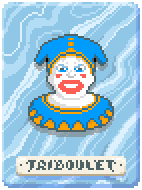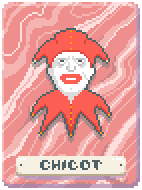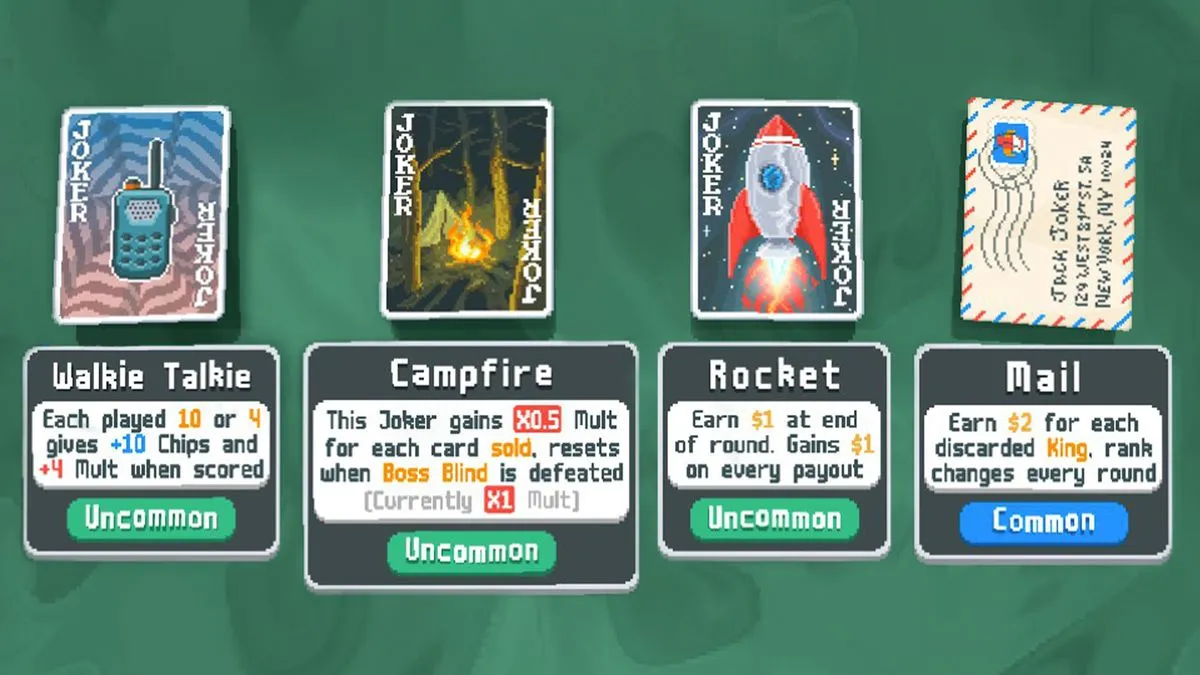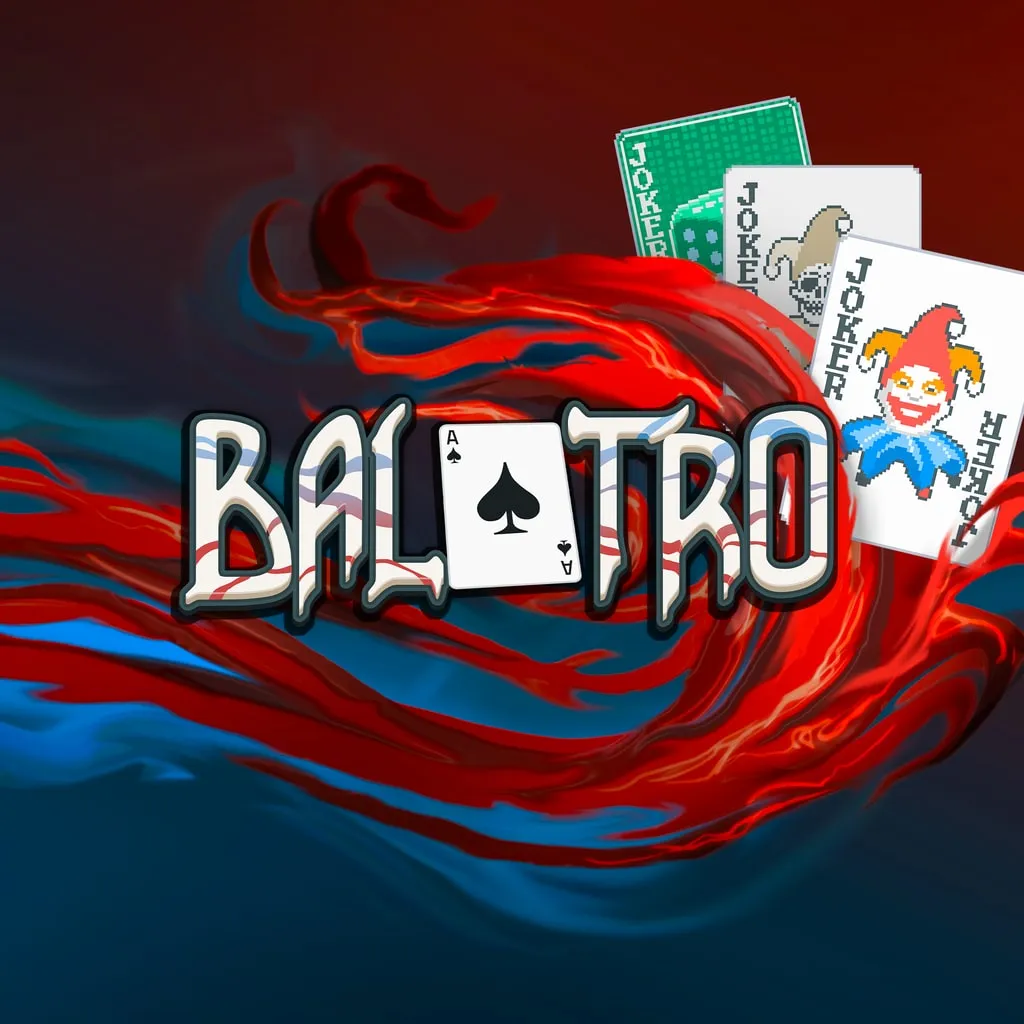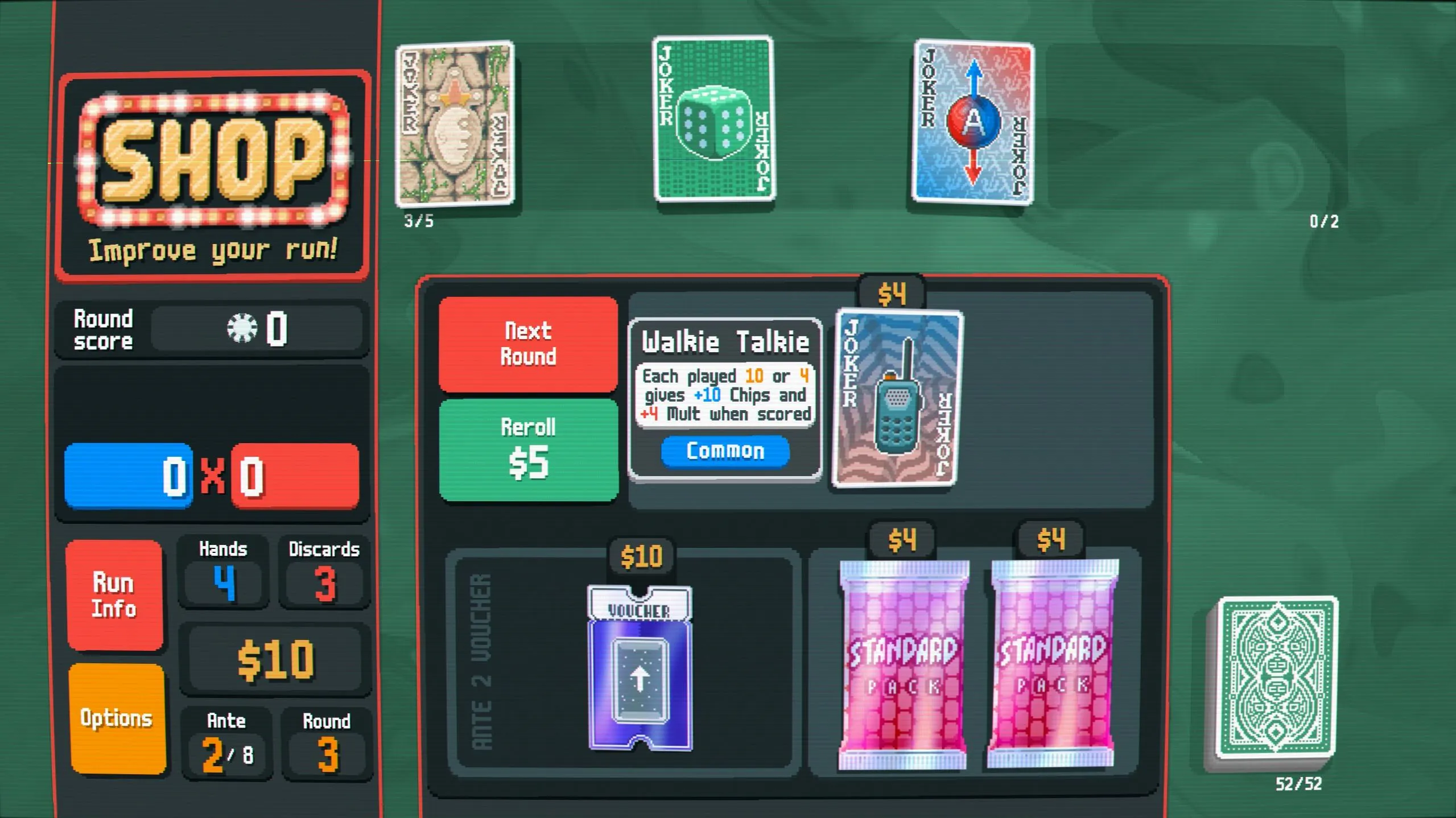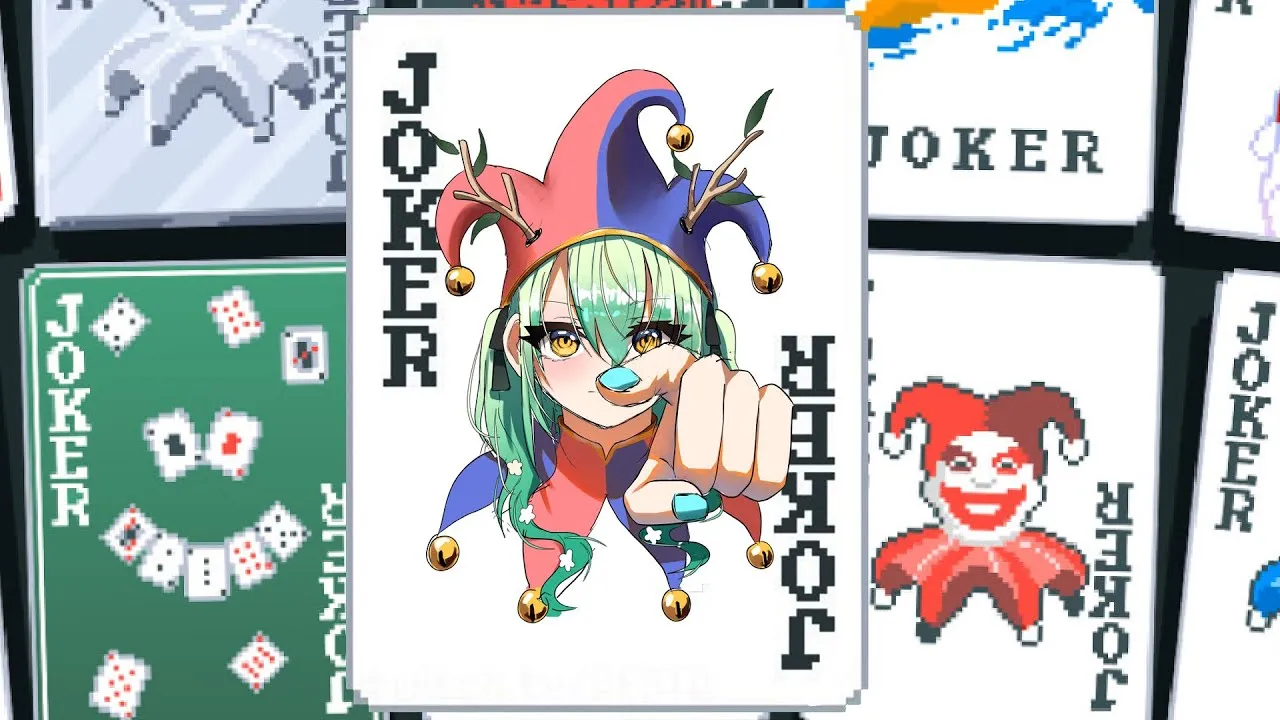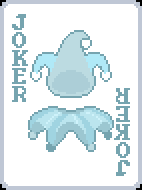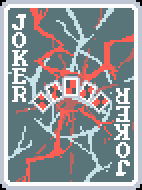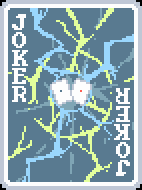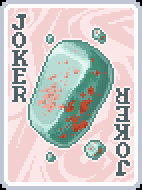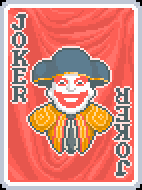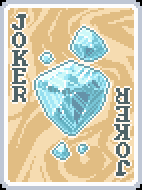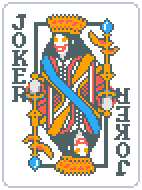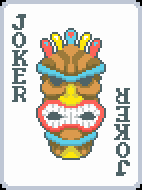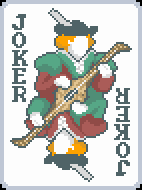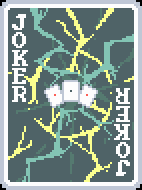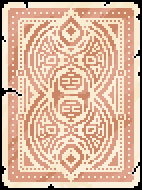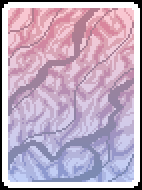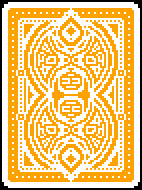Game Review: Balatro – Alexander Wales
The basis of Balatro is making poker hands. Every hand is worth some amount of chips and mult, and every card that makes up that hand is worth additional chips. Your goal each round is to get to some set number of chips using the number of hands you have available to you. After you win a round, you go to a shop, where you have a choice to buy upgrades to the base chips and mult of hands via planet cards, add more cards to your deck, buy “jokers” that have special effects, or alter the cards in your deck.
There, we’re past the part of the review where the overall gameplay is defined. I usually skim those, if it’s a game I’ve played before, and I don’t know that it’s super important, but it does seem obligatory.
The gameplay loop for Balatro has two phases that repeat. One phase is trying to build good hands, while the other phase is trying to build up your deck in the shop. This is a great gameplay loop, but it’s not groundbreaking, since it’s been a common roguelite staple for a while now. Where other roguelites might give you three options after beating a floor or enemy or whatever, Balatro’s shop is more expansive, with lots more in the way of choices. Even before any shop upgrades, there are two packs, two things, and a voucher to look over.
Balatro runs in cycles, and seems to be very aware of it. The number of chips you need to make goes up every round, which means there’s constant pressure to improve your jokers or your deck. Every three rounds there’s a boss battle with some special malus that makes things more difficult in some way, and after eight rounds, you’ve won the game. This cadence is really well done, because it adds in variety that I think could easily have not been there. The different sets of three rounds (called ‘antes’ in the game) aren’t really that distinctly different from each other, but they do provide a feeling that you’re moving along, which I think is done in some really clever ways.
Stages
While Balatro might divide itself into ‘blinds’ and ‘antes’, there are also some cleaving lines in terms of the mechanics. To make a score, you need both chips and mult, which you get from cards or jokers. Ideally, mult and chips are roughly balanced with each other, but there are some asymmetries in chips and mult that make it more interesting than that.
In the early game, chips tend to be more important, mostly because you can get them a little more easily. The first few antes are typically spent getting your first jokers, starting in on upgrading your deck, and getting the economy going. You gain money from a variety of sources, but money gained from interest is one of the most important ones, since the five dollars per round (unupgraded) is more than you’d get from almost any other single source.
The second stage of the game starts around the time you have a good source of chips. At that point, you have to start stacking +mult as much as possible, and +mult is going to outweigh the +chips pretty heavily. You’ll start trading in jokers to get more score, since you’ll have hit the joker limit. You have a strategy by this point, and while it’s not set in stone and is open to a pivot, you’re in building mode.
The third stage of the game is when you start trying to pick up as many copy effects and xmult jokers as you can. The deck starts to get very thin, the strategy is basically set in stone unless you can pull off a massive pivot, and you’re hunting for one or two very specific jokers to round out your collection. Most of what you’re doing is strategically playing the best hand you can and making sure that any “progressive” joker is progressing.
Because these stages are conceptual, I have a ton of fun trying to figure out what stage I’m in. Is it too late for a pivot? Will this joker give me the breathing room I need to rebuild my economy? Do I need to dig deep in order to get the killer joker now, or should I wait and try to limp to the next shop? Am I in “take anything” mode, or have I moved past that? I find the changing texture of each run as it goes on to be really engaging, much more than if I were doing the same thing at the end of a run that I was doing at the start of it.
A winning combination of jokers on Gold Stake difficulty And just when I’ve been in endgame mode for a bit, there’s the Ante 8 boss, and the game is either a win or a loss, which leads into the hidden fourth stage: Endless Mode. If the “game end” screen is Balatro knowing to get out while the getting is good, then Endless Mode is Balatro perfectly delivering on what I want from “one more turn”.
Endless ramps up the required score fast. Most winning runs will have trouble making it past Ante 9, and only exceptional runs make it past Ante 12. The extra stage isn’t the time sink I had feared it would be when I first tried it, and it somehow remains as engaging as the rest of the game, mostly because of the feeling that I’m fighting for every inch.
I think pacing is one thing that a lot of roguelites do poorly. It’s easy to see why they do it poorly, because every run is cobbled together from pieces, and with broken combos, you can easily end up effectively hitting “end turn” a bunch of times in a row. Balatro hardly ever does this, especially since the scaling means that even if you’re set for the ante, you’re still having to make strategic decisions for what’s coming in the future. I think of all the runs I’ve had, I’ve had a braindead “won run” where I was on autopilot only a handful of times.
Variety and Playspace
There are a lot of different aspects to Balatro, and they very quickly go from daunting to parseable. You have a number of hands and discards to play with. There are jokers, vouchers, planet cards, tarot cards, and playing cards. At any given moment, there are a lot of things to think about, and different jokers and playing hands dip into different aspects of the game.
You see a joker that gives you -1 Discard, then you have to think “okay, how does this change my ability to make the hands I need to make? Is this cost worth it?”.
You find a joker that adds a stone card to your deck every round, and you think “okay, can I make this work with the hands I’ve been making? Should I pivot? This is great with Hologram Joker and terrible with Erosion.”
The more you get to know the game, the deeper the choices feel, because you understand what might be coming down the pike and how the choices you make now change all your future choices.
One of the standards by which I judge any roguelite is “how different are the runs?” In this respect, Balatro knocks it out of the park. There are certain constants, like Blueprint almost always having a place in every single deck: it copies your best joker, and a second of your best joker is almost always worth getting rid of your worst joker for. Flushes are maybe a bit overpowered and straights are a little underpowered, at least as of 1.0.1e-FULL, which was the current beta branch patch at the time of this review. But I’ve had so many different runs, and there are a lot of ways to end up with weird things.
There are 150 jokers in the game, which I think is just about the perfect amount given the various rarities. Some of them are “junk” jokers that you’d never want to hold on to for long, some are perishable by their nature and will naturally make their exit at some point, and others are progressive jokers that get better with some effort. I do wish the legendries were maybe a bit less rare, since I can count the number of times I’ve seen them on one hand, but they’re a nice change of pace when they show up, and they usually define the run unless they come too late.
I’ve been sitting here staring at this screen for a bit trying to think of how many deck archetypes there are, and it’s actually more complicated than just “high card build”, because there are different ways of achieving high card build. There’s a steel-heavy high card build that uses the extra hand size to get multipliers and upgrades the hand, there’s Ride the Bus and Green Joker that boost mult based on the number of hands played … there are jokers that are great for a high card build, but not all high card builds need them, and there are winning tactics within the general high card archetype that sometimes conflict with each other. An example would be Stuntman, which gives a big pile of chips but reduces hand size. He’s great for high card, since you’re never scrambling to make a hand but he conflicts with a steel or Baron style build.
Even the jokers that I would consider to be duds can see some use in a pinch. Red Card requires a lot of investment to get going, and is one of the worst jokers, but I’ve won Gold Stake with it, and it wasn’t because I was trying to be contrary. Some of the junk jokers you grab at the start of the game end up defining your run, even if they’re gone by the time you get to Ante 8. I’ve gotten myself locked into three-of-a-kind build because it was necessary to push in that direction on the basis of what I had.
This is in contrast to something like Enter the Gungeon, which I have about 280 hours in. There, you’re not really building a run, you’re just collecting guns, and while they might play differently from each other, most of what you’re doing is not building up anything. You’re passing checks and getting more power as you go, but the runs sort of blend together with each other. This doesn’t really happen in Balatro. You get more powerful as the run goes on, but at least with the amount of time I’ve spent so far, it never feels like I’m following an algorithm to win. No game can stay fresh forever, but Balatro has already proven itself in the upper echelon of fresh-feeling games. It owes a lot of that to its variety.
Interesting Choices
One of the ways I define a game is as a series of interesting choices. There are other things that a game can have to make it worthwhile to play, like vibes, spectacle, or flow, but all my most favorite games have interesting choices at their core. Sometimes there’s such a thing as “optimal play”, but I usually consider that to be an extension of interesting choices, at least when the quest for optimal play has good gameplay.
An example of an uninteresting choice, from this very game I’m talking about:
Screenshot taken from this post, since I was too lazy to grab my own. Egg is a joker that gains $3 sell value every round. It has the Eternal sticker, which means you can’t sell it. There are, to my knowledge, two cards in the game that interact with it, both positively: the Temperance tarot card gives you the money equal to the sell value of jokers, and Swashbuckler has +mult equal to the sell value of other jokers. When you see this in the shop, it takes about two seconds to decide that you basically shouldn’t ever take it. It’ll take forever for it to be worth it on Temperance, and Swashbuckler would only be gaining +3 every round, which is basically nothing given that it takes two joker slots.
All that is at least mildly interesting to think about the first time, and then the time after that, you have the thoughts cached, and it’s as boring as picking out whether a picture is of a cat or a dog.
For the most part, Balatro does really well at having interesting choices. Unless you’re flat broke or in one of the rare “won runs”, it’s fun to peer around in the shop and try to see how new things might fit in. There are algorithms you build up for every run, such as “take every card” if you have Hologram or “take every 2” if you have Wee Joker or “remove face cards” with Ride the Bus … but for the most part, these are mutable algorithms which evolve over the course of play, and knowing when to bend a rule you’ve created like “don’t spend your last $25” is one of the things that makes you good at the game.
Similarly, the moment-to-moment decisions on what to discard and what to play take just the right amount of mulling over. It’s rare to get a deck to the point that you can just play whatever shows up, and there’s always a balance between digging for better cards or purple/blue seals to gain more power, and being able to make high scores or get money from reducing the number of hands played. All these little tensions come together and you find yourself thinking “alright, do I keep the steel for score, or ditch it and hope to draw the polychrome glass two of clubs?” or “is it better to play a Flush House here to unlock that planet card or stick with Flushes for the foreseeable future?”
One of the tricks that Balatro plays is that it doesn’t show you your score, and because of all the effects, it’s cumbersome to calculate by hand. I personally like this, since you get some “feel” of the deck as it goes, with an intuitive understanding per-run of what kinds of scores you’ll get from any particular hand. This, added with some of the spectacle of numbers going up and cards being counted, gives a lot of payoff to the questions that you ask yourself before any given hand is actually played. I’m personally a fan of this, but I’ve heard some complaints that the optimal thing to do is to track your score on a spreadsheet, which is proof of the maxim that players will optimize the fun out of anything.
Shuffling the Deck
Balatro is still under development. I think it’s great, and I trust the one-man dev team, but that’s a chance that it’ll change. The beta branch changes to Gold Stake difficulty have been great in my opinion, and while there are a few things that I would change to enhance the number of interesting decisions, it’s going great. There are a ton of mods already, and while I haven’t played them, I think there’s going to be plenty of options for adding more jokers, more classes of cards, more challenges, more modes, more decks, and all kinds of other things.
There’s a lot that’s not covered in this review, particularly some of the meta-progression elements, but those are more something to do within the game, rather than central to the game itself. There’s some pleasing structure to going up the stakes, trying out different decks, doing the challenges, and unlocking jokers, but it’s all built on the bones of a great central game.
There’s was something I saw in a behind-the-scenes feature on Halo many years ago, which is that all a game really needs is a fun five minutes. Once you have that, you can just do variations on that five minutes over and over again, and people will sink hundreds of hours into it. The key is that the small five minute segment of fun needs to be really well done. If the core is solid, everything else is will be easy.
Balatro delivers that in spades.
Addendum: Balatro is a Trash Game That No One Should Play
I’ve been making my way through the “stakes” for all the decks, along with the challenges. While the core gameplay is great, and I think it’s a game I’ll play for a long time after I’ve done everything there is to do, these last few things have not been terrible fun, and because I’m feeling salty about it, I’d like to go into why they’re not fun.
Thing the first: sometimes, you just lose.
The black deck’s special thing is that you get an extra joker slot at the cost of a hand per round. At orange stake, which I’m currently at, this means that you have 3 hands and 2 discards to get to the required score. This is worse than it first appears, because the number of hands remaining in a round determines how much money you get at the end, and this means you get one less dollar per round for the entire game, which tends to matter a lot more at the game start, where you’re building up economy. The trade off for this is that you eventually have an extra joker slot, but that doesn’t help until a few antes in, if that.
For a few hours now, I’ve been playing that first ante a lot, black deck, orange stake, and losing. Sometimes I crash at the second ante, and a few runs go further before withering or being cockblocked (more on that later), but the first ante losses really stick in my craw and make me think that this game is a piece of shit.
A first ante loss usually looks like this:
- In the first round, for the small blind you need 300 points. To get it in one fell swoop, you need to have a straight, flush, full house, or four-of-a-kind. Getting there without one of those can be iffy.
- You draw a random hand of cards, look at what you have, do some back-of-the-napkin math, decide that with your four diamonds you’re more likely to get a flush than trying to go for a straight (a straight with two outs has a 8/44 chance, while drawing a suited card when you’ve already seen one has a 9/44 chance). You discard everything that’s not part of the potential diamond flush.
- You draw trash. You don’t get the diamond you need, there’s another straight draw that is somehow worse, you would need to draw two cards in order to get a full house … so you ditch everything that’s not a diamond and try again. The odds of drawing that diamond you need are 9/40. (Technically the math is more complicated, because you’re drawing four cards, so it’s a 9/40 chance, then an 9/39 chance, then a 9/38 chance, then a 9/37 chance. The easiest way to calculate this is to invert it, so a 31/40 chance we don’t draw a diamond, then a 30/39 chance, etc., which, multiplied together, is a 37% chance we don’t draw a diamond, or a 63% chance that we do.)
- You draw trash again. You’re out of discards. Now if you want to get rid of cards to hunt for that missing diamond, you’re going to have to burn hands to do it. You’ve seen the cards that would have completed the straight from that first hand, and some other cards that would have made three of a kind if you knew they were coming. Using up a hand means one less dollar for the shop, but you’re out of options, and the odds are getting better. There are still 9 diamonds in the deck, and only 36 cards. That’s a 70% chance that you’ll draw at least one diamond.
- You draw trash again. You have two hands left. There are still no diamonds. Where have they all gone? You drew four on the first hand, and fuck, there should be more, right? You’ve seen 20 cards in this deck. There are 9 diamonds in the remaining 32 cards. So you throw down another hand of trash, which gets you minimal points, hunting for the flush that’s hopefully going to win you the game. You double check that your deck does, indeed, have diamonds. It does. They’re in there somewhere, just … at the bottom, I guess. There’s an 88% chance of drawing a diamond.
- You draw trash again. You have one hand left. There are still no diamonds. Where the fuck are the diamonds? You look at the cards, trying to see whether a straight or full house magically appeared, and of course it didn’t. The best hand you can play is a pair of Aces, which, with the other two garbage hands from earlier, is not enough. With nothing to do, you play the Aces, the hand doesn’t score enough, and you lose the game. Most first antes aren’t like this. You’re more likely to draw into the flush, straight, full house, or whatever you’re gunning for than you are to completely whiff on everything. But if the shop doesn’t contain a joker, planet card, or tarot that can make the difference, you’re doing the same thing the next ante, and maybe the ante after that. There are lots of chances to fail the first ante, and then lots of chances to fail the second ante if the right jokers don’t show up, which sometimes they don’t.
Eventually you learn some strategies for getting through those early blinds, like making sure in your hunt for a straight you’re not throwing away a flush, and you get some sense of how high the ranks of the cards need to be to make it, and you learn that it’s really really important to snag a first joker even if it’s only going to get you +4 mult, because that means for the boss you only need one good flush, not too. It gets marginally easily with a bit of skill and understanding.
But you still lose while playing the odds.
This is, in case it’s not clear, Not Fun. If what I love about this game is that it’s a series of interesting choices, then where I think it’s at its absolute most dogshit is when you’re spending time losing games while not actually getting to make interesting choices. There’s nothing interesting about deciding whether to shoot for a straight or a flush off that initial hand, it’s just math, and it’s the same math every time. All you do is lose while playing “perfectly” given your limited information. All you can do when you’ve played perfectly and lost is say “well, fuck me, I guess”.
This kind of thing is going to be inherent to any kind of game with an element of RNG in it, but my opinion on randomness in games is that the randomness is supposed to be there to give you a varied experience and let you respond to bumps in the road and engage in mitigation strategies. It’s fun to look at your deck and jokers and things and think “Alright, how do I shore this up? Do I shore it up? Do I play to my strengths instead? What am I hunting for, what makes this sing? How do I build a buffer and deal with worst case scenarios?” But when your deck is just a deck of 52 cards, and you have a single weak joker, and a single leveled hand, there’s none of that consideration, it’s just hoping that optimal play results in a win instead of a loss.
Thing the second: sometimes a boss steamrolls you.
The bosses in Slay the Spire, and to a lesser extent, the elites, are all there as “checks” of some kind. Specific bosses counter specific playstyles and constructions, and part of their mechanical role is to make sure that your deck has some flexibility to it. You run into a gang of goblins, and the check is “Can your deck do AOE?”. Then you run into a giant beast of a guy and the check is “Can your deck output a lot of damage in a short period?” I think this is good design, so long as the player understands it, which the player should because one of these checks is likely to kill them. That’s usually a good way to teach a lesson. There are different ways to get by the checks, and sometimes, if your deck is good enough, you can just brute force through it. Other times, you do just enough to limp through while crushing everything else.
I mention Slay the Spire because I think it’s basically impossible that the dev of Balatro didn’t play it, and I’m pretty sure that those “checks” serve as some inspiration for the bosses of Balatro. I also think that for a few reasons, some of the bosses of Balatro end up being unfun.
Most of building a run in Balatro is about what shows up in the shops. Especially on higher stakes, you’re forced into taking things even if you don’t like them and don’t think they’re particularly good. A joker that makes clubs really good shows up, and you take it because it can get you through an ante, then you’re already doing club flushes so you pick up a card to make more clubs, and a card to upgrade flushes, and eventually you’re pigeon-holed.
Then you run into a boss that says “Clubs are debuffed” and there’s no combination of hands you can make to get the score you need.
So what’s the counterplay? There are a few things. First, if you know all the bosses because you’ve put 200 hours into the game, you can think about diversification and that becomes a part of the strategy end of the game. If you know that “Clubs are debuffed” is in the mix, maybe you hold off on converting the entire deck into clubs, and you make sure that you can maybe get the points you need if that boss shows up. Second, there’s a voucher the lets you reroll the boss blind, but that doesn’t always show up. Third, there’s a joker you can sell to disable the boss blind, but that doesn’t always show up and it takes a valuable joker slot, so is non-viable most of the time. Fourth, because you can see the bosses coming at the start of the ante, you have three shops in which to pivot.
Sometimes this is okay. Fun, even. Successfully pulling off a major pivot feels great. Other times, there’s just nothing in the shops in spite of spending down on rerolls, and you’ve built your run too much around the very specific thing the boss is punishing or checking against. Some of that is just skill issue: you knew that boss was in the mix, but you did your club flush build instead, and who’s really to blame for that?
Sometimes it just feels like a promising run has been killed by random chance. I think this is especially the case because there are 23 bosses and you don’t see all of them in any given run (only 7, since the 8th ante has a Finisher Boss), so the risk you’re taking isn’t enormous if you do decide on a specific thing you know will be punished. When you’re falling into a face card build, you think “well, I’m on Ante 4, I can see that this boss won’t punish, that means there are three bosses who could gank me”. So you go all in on face cards, and you bet wrong, and you lose, which isn’t the worst, because at least it’s your fault. Or you try to build a build so powerful that it can just power through the debuff, which is possible, and feels great.
I don’t necessarily know that I have a proposed solution to the bosses. It really does seem to me like there are only a few bosses that just completely shut down some runs with a major (sometimes impossible) pivot being your only option. I think I would rather be kneecapped, rather than have my throat slit. Maybe there could be an intermediary step between “normal card” and “debuff”.
Alright, I found this cathartic. I’m going to go bash my head against black deck orange stake for a bit, and when I finally find a win, I’ll do gold stake, and then will have that checked off as an accomplishment I have no interest in repeating.
If you have found a spelling error, please, notify us by selecting that text and pressing Ctrl+Enter.
Game Review: Balatro
The following text will be sent to our editors:
このサイトはコレクションに関連する記事のみを収集しています。元のテキストを表示するには、以下のリンクをコピーして開いてください:Game Review: Balatro – Alexander Wales

